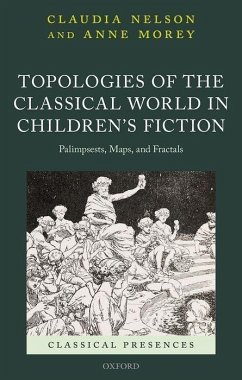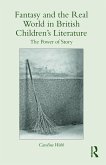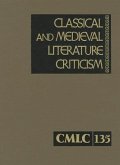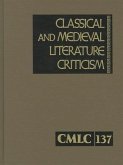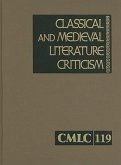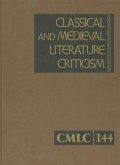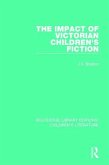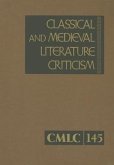Claudia Nelson, Anne Morey
Topologies of the Classical World in Children's Fiction
Palimpsests, Maps, and Fractals
Claudia Nelson, Anne Morey
Topologies of the Classical World in Children's Fiction
Palimpsests, Maps, and Fractals
- Gebundenes Buch
- Merkliste
- Auf die Merkliste
- Bewerten Bewerten
- Teilen
- Produkt teilen
- Produkterinnerung
- Produkterinnerung
Drawing on a cognitive poetics approach to reception studies, this volume examines the use of spatial metaphors - palimpsest, map, and fractal - to organize the classical past for preteen and adolescent readers, arguing that these reflect different modes in children's literature and encourage different cognitive effects in readers.
Andere Kunden interessierten sich auch für
![Fantasy and the Real World in British Children's Literature Fantasy and the Real World in British Children's Literature]() Caroline WebbFantasy and the Real World in British Children's Literature229,99 €
Caroline WebbFantasy and the Real World in British Children's Literature229,99 €![Classical and Medieval Literature Criticism, Volume 135: Criticism of the Works of World Authors from Classical Antiquity Through the Fourteenth Centu Classical and Medieval Literature Criticism, Volume 135: Criticism of the Works of World Authors from Classical Antiquity Through the Fourteenth Centu]() Classical and Medieval Literature Criticism, Volume 135: Criticism of the Works of World Authors from Classical Antiquity Through the Fourteenth Centu627,99 €
Classical and Medieval Literature Criticism, Volume 135: Criticism of the Works of World Authors from Classical Antiquity Through the Fourteenth Centu627,99 €![Classical and Medieval Literature Criticism: Criticism of the Works of World Authors from Classical Antiquity Through the Fourteenth Century, from the Classical and Medieval Literature Criticism: Criticism of the Works of World Authors from Classical Antiquity Through the Fourteenth Century, from the]() Classical and Medieval Literature Criticism: Criticism of the Works of World Authors from Classical Antiquity Through the Fourteenth Century, from the627,99 €
Classical and Medieval Literature Criticism: Criticism of the Works of World Authors from Classical Antiquity Through the Fourteenth Century, from the627,99 €![Classical and Medieval Literature Criticism, Volume 119: Criticism of the Works of World Authors from Classical Antiquity Through the Fourteenth Centu Classical and Medieval Literature Criticism, Volume 119: Criticism of the Works of World Authors from Classical Antiquity Through the Fourteenth Centu]() Classical and Medieval Literature Criticism, Volume 119: Criticism of the Works of World Authors from Classical Antiquity Through the Fourteenth Centu610,99 €
Classical and Medieval Literature Criticism, Volume 119: Criticism of the Works of World Authors from Classical Antiquity Through the Fourteenth Centu610,99 €![Classical and Medieval Literature Criticism, Volume 144: Criticism of the Works of World Authors from Classical Antiquity Through the Fourteenth Centu Classical and Medieval Literature Criticism, Volume 144: Criticism of the Works of World Authors from Classical Antiquity Through the Fourteenth Centu]() Classical and Medieval Literature Criticism, Volume 144: Criticism of the Works of World Authors from Classical Antiquity Through the Fourteenth Centu627,99 €
Classical and Medieval Literature Criticism, Volume 144: Criticism of the Works of World Authors from Classical Antiquity Through the Fourteenth Centu627,99 €![The Impact of Victorian Children's Fiction The Impact of Victorian Children's Fiction]() J S BrattonThe Impact of Victorian Children's Fiction202,99 €
J S BrattonThe Impact of Victorian Children's Fiction202,99 €![Classical and Medieval Literature Criticism, Volume 145: Criticism of the Works of World Authors from Classical Antiquity Through the Fourteenth Centu Classical and Medieval Literature Criticism, Volume 145: Criticism of the Works of World Authors from Classical Antiquity Through the Fourteenth Centu]() Classical and Medieval Literature Criticism, Volume 145: Criticism of the Works of World Authors from Classical Antiquity Through the Fourteenth Centu627,99 €
Classical and Medieval Literature Criticism, Volume 145: Criticism of the Works of World Authors from Classical Antiquity Through the Fourteenth Centu627,99 €-
-
-
Drawing on a cognitive poetics approach to reception studies, this volume examines the use of spatial metaphors - palimpsest, map, and fractal - to organize the classical past for preteen and adolescent readers, arguing that these reflect different modes in children's literature and encourage different cognitive effects in readers.
Hinweis: Dieser Artikel kann nur an eine deutsche Lieferadresse ausgeliefert werden.
Hinweis: Dieser Artikel kann nur an eine deutsche Lieferadresse ausgeliefert werden.
Produktdetails
- Produktdetails
- Verlag: Oxford University Press (UK)
- Seitenzahl: 288
- Erscheinungstermin: 24. Dezember 2019
- Englisch
- Abmessung: 218mm x 140mm x 28mm
- Gewicht: 476g
- ISBN-13: 9780198846031
- ISBN-10: 0198846037
- Artikelnr.: 57009308
- Herstellerkennzeichnung
- Produktsicherheitsverantwortliche/r
- Europaallee 1
- 36244 Bad Hersfeld
- gpsr@libri.de
- Verlag: Oxford University Press (UK)
- Seitenzahl: 288
- Erscheinungstermin: 24. Dezember 2019
- Englisch
- Abmessung: 218mm x 140mm x 28mm
- Gewicht: 476g
- ISBN-13: 9780198846031
- ISBN-10: 0198846037
- Artikelnr.: 57009308
- Herstellerkennzeichnung
- Produktsicherheitsverantwortliche/r
- Europaallee 1
- 36244 Bad Hersfeld
- gpsr@libri.de
Claudia Nelson has published widely on nineteenth- and twentieth-century British and American children's literature and family studies. Her book Little Strangers: Portrayals of Adoption and Foster Care in America, 1850-1929 (Indiana University Press, 2003) won the Children's Literature Association award for the best scholarly book in the field of children's studies. A professor of English at Texas A&M University, she is a former president of the Children's Literature Association and a former editor of the Children's Literature Association Quarterly. Anne Morey is an associate professor of English at Texas A&M University. Her book Hollywood Outsiders: The Adaptation of the Film Industry, 1913-1934 (University of Minnesota Press, 2003) deals with Hollywood's critics and co-opters, and she has also edited a volume on Stephenie Meyer's "Twilight" phenomenon, Genre, Reception, and Adaptation in the 'Twilight' Series (Routledge, 2012). She is currently at work on a book about the Junior Literary Guild and children's reading from 1929-1955 and is co-writing a book with Shelley Stamp on women in American silent cinema.
* Frontmatter
* List of Illustrations
* 1: Introduction
* 1.1: The Models
* 1.2: Sample Exception #1: Mirroring in Echo Echo
* 1.3: Sample Exception #2: Insides and Outsides in Bull
* 1.4: Sample Exception #3: Curves vs. Straight Lines in The Mark of
the Horse Lord
* 1.5: Conclusion
* 2: HISTORY IS A PALIMPSEST 1: The Layers of Ancient Rome in Puck of
Pook's Hill and Its Successors
* 2.1: Foundations: Puck of Pook's Hill
* 2.2: Layers for Adults: Three Fantasies
* 2.3: Layers for Children: Three Fantasies
* 2.4: Beyond Fantasy: Philip Turner's Yorkshire Palimpsest
* 2.5: Conclusion
* 3: HISTORY IS A PALIMPSEST 2: Time Zones, Scars, and Family in
(Mostly) Realistic Works
* 3.1: Magical Rules and Classical Tradition in The Enchanted Castle
* 3.2: Liminality and Mixed Metaphors in Three Novels by Caroline Dale
Snedeker
* 3.3: Trauma, Family, and History in The Bronze Bow
* 3.4: Wounding in The Eagle of the Ninth
* 3.5: Conclusion
* 4: HISTORY IS A MAP 1: Navigating the Underworld
* 4.1: A Map Text Without a Map: The Story of the Amulet
* 4.2: Underworlds and (Platonic) Caves in The Silver Chair
* 4.3: Underworlds and Returns in Mystery at Mycenae and The Roman
Mysteries
* 4.4: Symbolic Underworlds and Shifting Scripts in the Roman Pony
Trilogy
* 4.5: Mapping the Orpheus Myth in the Jack Perdu Books and the
Underworlds Series
* 4.6: Conclusion
* 5: HISTORY IS A MAP 2: Carnivals, Grotesquerie, and the Antic(que)
Map Text
* 5.1: Gryllus the Pig and the Playful Attack on Borders
* 5.2: Spartapuss the Cat and the Repeating and Consuming of Time
* 5.3: Julius Zebra and Cognitive Connection through Words, Pictures,
and Warthogs
* 5.4: The Dogs of Pompeii and Popular Culture's Alliance with the Past
* 5.5: Percy Jackson and the Apotheosis of the Comic Didactic
* 5.6: Conclusion
* 6: HISTORY IS FRACTAL: Patterns of Conflict in Contemporary Young
Adult Fantasies
* 6.1: Despairing Didacticism: Learning and Misery in Red Shift
* 6.2: Separate Spheres and If Worlds: Culture Clash in the Fireball
and Warriors Trilogies
* 6.3: Panem et Circenses: Countries, Cats, and Conflict in the Hunger
Games Trilogy
* 6.4: Monsters and Masks: Trust and Treachery in the Ember in the
Ashes Series
* 6.5: Secret Keepers: Manipulating Misprision in The Queen's Thief
Sequence
* 6.6: Conclusion
* 7: Conclusion
* Endmatter
* Works Cited
* Index
* List of Illustrations
* 1: Introduction
* 1.1: The Models
* 1.2: Sample Exception #1: Mirroring in Echo Echo
* 1.3: Sample Exception #2: Insides and Outsides in Bull
* 1.4: Sample Exception #3: Curves vs. Straight Lines in The Mark of
the Horse Lord
* 1.5: Conclusion
* 2: HISTORY IS A PALIMPSEST 1: The Layers of Ancient Rome in Puck of
Pook's Hill and Its Successors
* 2.1: Foundations: Puck of Pook's Hill
* 2.2: Layers for Adults: Three Fantasies
* 2.3: Layers for Children: Three Fantasies
* 2.4: Beyond Fantasy: Philip Turner's Yorkshire Palimpsest
* 2.5: Conclusion
* 3: HISTORY IS A PALIMPSEST 2: Time Zones, Scars, and Family in
(Mostly) Realistic Works
* 3.1: Magical Rules and Classical Tradition in The Enchanted Castle
* 3.2: Liminality and Mixed Metaphors in Three Novels by Caroline Dale
Snedeker
* 3.3: Trauma, Family, and History in The Bronze Bow
* 3.4: Wounding in The Eagle of the Ninth
* 3.5: Conclusion
* 4: HISTORY IS A MAP 1: Navigating the Underworld
* 4.1: A Map Text Without a Map: The Story of the Amulet
* 4.2: Underworlds and (Platonic) Caves in The Silver Chair
* 4.3: Underworlds and Returns in Mystery at Mycenae and The Roman
Mysteries
* 4.4: Symbolic Underworlds and Shifting Scripts in the Roman Pony
Trilogy
* 4.5: Mapping the Orpheus Myth in the Jack Perdu Books and the
Underworlds Series
* 4.6: Conclusion
* 5: HISTORY IS A MAP 2: Carnivals, Grotesquerie, and the Antic(que)
Map Text
* 5.1: Gryllus the Pig and the Playful Attack on Borders
* 5.2: Spartapuss the Cat and the Repeating and Consuming of Time
* 5.3: Julius Zebra and Cognitive Connection through Words, Pictures,
and Warthogs
* 5.4: The Dogs of Pompeii and Popular Culture's Alliance with the Past
* 5.5: Percy Jackson and the Apotheosis of the Comic Didactic
* 5.6: Conclusion
* 6: HISTORY IS FRACTAL: Patterns of Conflict in Contemporary Young
Adult Fantasies
* 6.1: Despairing Didacticism: Learning and Misery in Red Shift
* 6.2: Separate Spheres and If Worlds: Culture Clash in the Fireball
and Warriors Trilogies
* 6.3: Panem et Circenses: Countries, Cats, and Conflict in the Hunger
Games Trilogy
* 6.4: Monsters and Masks: Trust and Treachery in the Ember in the
Ashes Series
* 6.5: Secret Keepers: Manipulating Misprision in The Queen's Thief
Sequence
* 6.6: Conclusion
* 7: Conclusion
* Endmatter
* Works Cited
* Index
* Frontmatter
* List of Illustrations
* 1: Introduction
* 1.1: The Models
* 1.2: Sample Exception #1: Mirroring in Echo Echo
* 1.3: Sample Exception #2: Insides and Outsides in Bull
* 1.4: Sample Exception #3: Curves vs. Straight Lines in The Mark of
the Horse Lord
* 1.5: Conclusion
* 2: HISTORY IS A PALIMPSEST 1: The Layers of Ancient Rome in Puck of
Pook's Hill and Its Successors
* 2.1: Foundations: Puck of Pook's Hill
* 2.2: Layers for Adults: Three Fantasies
* 2.3: Layers for Children: Three Fantasies
* 2.4: Beyond Fantasy: Philip Turner's Yorkshire Palimpsest
* 2.5: Conclusion
* 3: HISTORY IS A PALIMPSEST 2: Time Zones, Scars, and Family in
(Mostly) Realistic Works
* 3.1: Magical Rules and Classical Tradition in The Enchanted Castle
* 3.2: Liminality and Mixed Metaphors in Three Novels by Caroline Dale
Snedeker
* 3.3: Trauma, Family, and History in The Bronze Bow
* 3.4: Wounding in The Eagle of the Ninth
* 3.5: Conclusion
* 4: HISTORY IS A MAP 1: Navigating the Underworld
* 4.1: A Map Text Without a Map: The Story of the Amulet
* 4.2: Underworlds and (Platonic) Caves in The Silver Chair
* 4.3: Underworlds and Returns in Mystery at Mycenae and The Roman
Mysteries
* 4.4: Symbolic Underworlds and Shifting Scripts in the Roman Pony
Trilogy
* 4.5: Mapping the Orpheus Myth in the Jack Perdu Books and the
Underworlds Series
* 4.6: Conclusion
* 5: HISTORY IS A MAP 2: Carnivals, Grotesquerie, and the Antic(que)
Map Text
* 5.1: Gryllus the Pig and the Playful Attack on Borders
* 5.2: Spartapuss the Cat and the Repeating and Consuming of Time
* 5.3: Julius Zebra and Cognitive Connection through Words, Pictures,
and Warthogs
* 5.4: The Dogs of Pompeii and Popular Culture's Alliance with the Past
* 5.5: Percy Jackson and the Apotheosis of the Comic Didactic
* 5.6: Conclusion
* 6: HISTORY IS FRACTAL: Patterns of Conflict in Contemporary Young
Adult Fantasies
* 6.1: Despairing Didacticism: Learning and Misery in Red Shift
* 6.2: Separate Spheres and If Worlds: Culture Clash in the Fireball
and Warriors Trilogies
* 6.3: Panem et Circenses: Countries, Cats, and Conflict in the Hunger
Games Trilogy
* 6.4: Monsters and Masks: Trust and Treachery in the Ember in the
Ashes Series
* 6.5: Secret Keepers: Manipulating Misprision in The Queen's Thief
Sequence
* 6.6: Conclusion
* 7: Conclusion
* Endmatter
* Works Cited
* Index
* List of Illustrations
* 1: Introduction
* 1.1: The Models
* 1.2: Sample Exception #1: Mirroring in Echo Echo
* 1.3: Sample Exception #2: Insides and Outsides in Bull
* 1.4: Sample Exception #3: Curves vs. Straight Lines in The Mark of
the Horse Lord
* 1.5: Conclusion
* 2: HISTORY IS A PALIMPSEST 1: The Layers of Ancient Rome in Puck of
Pook's Hill and Its Successors
* 2.1: Foundations: Puck of Pook's Hill
* 2.2: Layers for Adults: Three Fantasies
* 2.3: Layers for Children: Three Fantasies
* 2.4: Beyond Fantasy: Philip Turner's Yorkshire Palimpsest
* 2.5: Conclusion
* 3: HISTORY IS A PALIMPSEST 2: Time Zones, Scars, and Family in
(Mostly) Realistic Works
* 3.1: Magical Rules and Classical Tradition in The Enchanted Castle
* 3.2: Liminality and Mixed Metaphors in Three Novels by Caroline Dale
Snedeker
* 3.3: Trauma, Family, and History in The Bronze Bow
* 3.4: Wounding in The Eagle of the Ninth
* 3.5: Conclusion
* 4: HISTORY IS A MAP 1: Navigating the Underworld
* 4.1: A Map Text Without a Map: The Story of the Amulet
* 4.2: Underworlds and (Platonic) Caves in The Silver Chair
* 4.3: Underworlds and Returns in Mystery at Mycenae and The Roman
Mysteries
* 4.4: Symbolic Underworlds and Shifting Scripts in the Roman Pony
Trilogy
* 4.5: Mapping the Orpheus Myth in the Jack Perdu Books and the
Underworlds Series
* 4.6: Conclusion
* 5: HISTORY IS A MAP 2: Carnivals, Grotesquerie, and the Antic(que)
Map Text
* 5.1: Gryllus the Pig and the Playful Attack on Borders
* 5.2: Spartapuss the Cat and the Repeating and Consuming of Time
* 5.3: Julius Zebra and Cognitive Connection through Words, Pictures,
and Warthogs
* 5.4: The Dogs of Pompeii and Popular Culture's Alliance with the Past
* 5.5: Percy Jackson and the Apotheosis of the Comic Didactic
* 5.6: Conclusion
* 6: HISTORY IS FRACTAL: Patterns of Conflict in Contemporary Young
Adult Fantasies
* 6.1: Despairing Didacticism: Learning and Misery in Red Shift
* 6.2: Separate Spheres and If Worlds: Culture Clash in the Fireball
and Warriors Trilogies
* 6.3: Panem et Circenses: Countries, Cats, and Conflict in the Hunger
Games Trilogy
* 6.4: Monsters and Masks: Trust and Treachery in the Ember in the
Ashes Series
* 6.5: Secret Keepers: Manipulating Misprision in The Queen's Thief
Sequence
* 6.6: Conclusion
* 7: Conclusion
* Endmatter
* Works Cited
* Index

